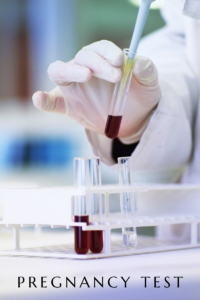If you are like most people you may not know a lot about how a pregnancy testing actually works.
You probably know the basics; pee on the test strip and if a line shows up…you are pregnant!
- If you are looking forward to having a baby you are excited and want to tell everybody.
- If you don’t want to be pregnant you are probably sitting on the toilet in the bathroom saying, “I am so screwed!”
But what if the pregnancy testing is negative….can you really be pregnant with a negative pregnancy test?
Understanding how pregnancy testing works will help you better understand the limitations of the test…when to test and when not to test, what any given test result means, and the pros and cons of urine vs. blood pregnancy testing.
After reading this article you should better understand how a pregnancy test turns positive and what a negative pregnancy test really means.
What happens when you get pregnant?
Pregnancy happens when a sperm fertilizes an egg.
In a previous article, we explained the menstrual cycle and how pregnancy hijacks your menstrual cycle and stops you from having periods. If you have not read this previous article you should take some time to do so because it will help you better understand your menstrual cycle.
Previous article: Increasing Chances of Getting Pregnant: Understand Your Menstrual Cycle
Brief review. A healthy woman will release one egg every month. On random months, some women may release two eggs in month (possible twins) on a single day and, on rarer occasions, release three eggs (possible triplets) on a single day in a given month. Most women will only release one egg a month.
Some women may not consistently release eggs. This is a common condition and a common cause of infertility. This condition is called anovulation (not ovulating).
More information: Understanding ovulation problems
Ovulation. Most women will usually release one egg from one of their two ovaries (ovulate) 14 days after their period begins. Egg release is caused by the FSH/LH surge.
More information: Understanding the FSH/LH surge
The egg can only survive for approximately 24 hours after being released from the ovary .
- If an egg is fertilized by a sperm within the first 24 hours then pregnancy will occur.
- If the egg is not fertilized within 24 hours then the egg will die, get absorbed by the female’s body, and the menstrual cycle will repeat itself in two weeks.
The female menstrual cycle is controlled by the woman’s brain and pituitary but when a woman becomes pregnant…. the fertilized egg hijacks the system and now becomes the driver. The brain and pituitary both take a back seat for the next 9 months!
Fertilization. Fertilization of the egg usually happens in the very end of the fallopian tube…near the fimbrial end of the tube in the wider portion of the tube called the ampullary portion of the fallopian tube.
Once the egg is fertilized it takes approximately 1 to 5 days after fertilization for the fertilized egg to travel the entire length of the fallopian tube and get inside the uterus.
During the time the egg is traveling down the fallopian tube the early cells are growing and dividing.
Approximately 5 to 6 days after fertilization the egg is ready to attach and implant in the uterine lining.
Implantation. Typically implantation of a fertilized egg into the uterine lining occurs approximately 5 to 7 days after ovulation or, another way to think about it, implantation occurs about a week before you would miss your period.
Only fertilized eggs can attach and implant in the uterine lining. Unfertilized eggs are unable to attach to the uterine lining.
The Pregnancy Hormone HCG? What is this stuff all about?
HCG is the short name for Human Chorionic Gonadotropin and it is what is commonly referred to as the “Pregnancy Hormone”.
HCG has many functions but the main function of HCG is to act as a hormonal messenger.
HCG is released by the early fertilized egg. The HCG is secreted into the blood stream and the blood stream takes the HCG back to the ovary.
HCG released from the fertilized egg tells the ovary to keep making progesterone.
HCG: “The Eagle Has Landed!” Analogy
To better understand how HCG works it is helpful to use a historical analogy. When I think of HCG I think of Neil Armstrong’s first words when he landed on the moon.
America was determined to be the first country to land humans on the moon. This was a scientific feat that was challenging and required practice, precision, skill and luck….just like getting pregnant!
The Apollo 11 rocket had to take off from earth, circle the moon, and land on the moon. Not only did they have to do all that…but they had to get back on earth by doing everything in reverse! Landing on the moon is much harder than getting pregnant.
Among the many technical problems was communication. Mission control had to talk to the astronauts of the Apollo 11 mission through a complex sequence of events….just like the brain has to talk to the ovary, which then has to talk to the uterus and early pregnancy. Without communication the Apollo 11 mission would not have been successful.
After Neil Armstrong successfully landed on the moon, he famously said, “The Eagle has landed!”
This message was communicated back to Mission Control to let them know that the lunar landing was safely completed. Mission control then knew the landing was successful and they continued to relay instructions to the astronauts to finish the mission.

In many ways a fertilized egg is like the Lunar Lander, Neil Armstrong’s message to mission control is the HCG hormonal signal and the ovarian corpus luteal cyst is Mission Control.
HCG is the pregnancy’s announcement “The Eagle has landed!” The HCG relates the message that fertilization and implantation were successful and pregnancy has occurred.
HCG: Tells Ovary “All Systems Go!”
The main function of HCG is to let the ovary know successful implantation of a fertilized egg has occurred.
After the ovary releases an egg, a small cyst (or blister) forms on the surface of the ovary. This cyst is called a corpus luteum, which is Latin for ‘yellow body’. This normal monthly cysts gets its name because the hormones concentrated in the cyst make it visually appear yellow.
The corpus luteum makes progesterone hormone. Progesterone is a hormone released into the blood stream and ultimately delivered to the uterine lining. It tells the uterine lining to stay attached, stay fluffy, and to continue to nourish the fertilized egg.
You get an increase in progesterone during the last two weeks of your cycle. Progesterone is also the hormone that makes some women grumpy, bloated, and have sore/tender breast.
- Once you release an egg…the blister that remains starts producing progesterone.
- The blister is called a corpus luteum. Once the corpus luteum forms it has an internal timer. If the corpus luteum does not get a message from the fertilized egg it undergoes a preprogrammed death in 7 to 10 days. If the corpus luteum does not detect HCG, then it shrinks away, stops making progesterone, and the uterine lining then falls off.
- If the corpus luteum detects HCG it continues to make progesterone to support the early developing pregnancy and tells the uterine lining to continue to nurture the fertilized egg. Progesterone is critical for the pregnancy during the first 8 to 12 weeks. The corpus luteum makes progesterone the first 10 weeks. Starting week 9 the early placenta begins to make progesterone and at 12 weeks the placenta takes over total progesterone production. HCG levels gradually decline after 12 weeks and the corpus luteum goes through programmed shut down. The pregnancy has taken over full control around 12 weeks gestational age.
So…if the woman’s body sees HCG it gets a chemical message fertilization and implantation has occurred and the ovary keeps paying child support until the baby can take care of itself.
If the woman’s body does not see HCG then the ovary knows the pregnancy did not make it and its time to start all over again.
How does the HCG test work?
If you have carefully read the material above…then you understand HCG does not exist for you so you can take a pregnancy test and find out if you are pregnant!

HCG is only produced by your body in two situations: 1) when you are pregnant or 2) when you have a rare form of cancer (some rare cancer cells abnormally make HCG).
Since pregnancy is common and cancers cells that make HCG are rare…if you have a positive pregnancy test and are young and skipped a period then you are most likely pregnant and you don’t have a rare form of cancer.
Once HCG is produced it gets absorbed into the blood stream. The ovaries detect the HCG hormone and the ovaries hears the message. Gradually HCG levels build up in the body. The kidneys filter the blood of impurities and HCG will then spill into the urine. As far as the kidney is concerned, HCG is a waste product that needs to be eliminated.
Scientist long ago realized that as soon as HCG appears in the blood HCG then starts to appear in the urine. Based on these two observations, they began to develop blood and urine tests that detect HCG hormone.
- If HCG is not detected then you are not pregnant.
- When HCG is detected then you are pregnant (or in rare cases have an extremely rare form of cancer).
History pregnancy testing: The Rabbit Test!
If you think interpreting a modern urine pregnancy test is difficult then you should understand how the first ‘modern’ pregnancy test worked.
In the old, old days a woman could only tell if she was pregnant when she skipped her periods, threw up, her belly got bigger and something inside started moving on its own. If you think diagnosing pregnancy is hard now…be glad you’d did not live in the early before the early 1900’s.
Do you know anything about the first ‘modern’ pregnancy test?

Although HCG was first discovered in the 1920’s, we did not have an easy test for it. We understood the basics of HCG, knew it was a pregnancy hormone, and knew it could easily be found in the blood and in the urine.
In the 1950’s scientist developed a rabbit test for pregnancy (no joke)!
If a woman thought she was pregnant and wanted to know….her doctor would order a Rabbit Test.
The woman would give the doctor a urine sample. Someone from the lab would inject the urine sample into a female rabbit. Several days later they would kill the rabbit and examine the ovaries of the female rabbit. The test was considered 98% accurate.
- If HCG was present in the woman’s urine it would cause changes in the rabbit’s ovaries that could easily be seen under a microscope.
- If HCG was not present in the woman’s urine then the rabbit’s ovaries would not have pregnancy changes.
The Rabbit Test was how pregnancy was diagnosed in the 1950’s and 1960’s. Unfortunately all rabbits died and it was a horrible test to determine if you were pregnant…mainly it took too long and resulted in the unnecessary death of an animal.
So if you find yourself complaining about your store bought pregnancy test…be glad you were not a woman in the 1950’s worried about being pregnant!
You would have to kill a couple of rabbits to determine if you were pregnant. If you could not take the Rabbit Test then you would just wait until your belly stuck out so far there was no doubt….or if you were so obese you could not rely on a belly check then you would find out you were pregnant when you were in labor.
Modern Pregnancy Test: Qualitative vs Quantitative Testing
You can’t understand modern pregnancy testing unless you understand there are two categories of pregnancy test: qualitative and quantitative.
- Qualitative. Looks at qualities and provides a “Yes HCG is present” or “No HCG is present” answer.
- Quantitative. Looks at amounts of HCG and provides a definite amount in numbers.
It is always best to start with a qualitative test first….one that gives you a “Yes” or “No” answer.
- A urine pregnancy test is a qualitative test. It gives you a “Yes” or “No” answer.
- A blood test can be either a qualitative or quantitative test and depends on which one the doctor orders from the lab.
A qualitative blood pregnancy test will give you a “Yes” or “No” answer. A quantitative blood pregnancy test gives you an exact level of the pregnancy hormone…usually a number amount.
Most doctors offices will confirm pregnancy with a qualitative urine pregnancy test and, if medically required, follow the urine pregnancy test up with a quantitative blood pregnancy test which is commonly referred to as a quantitative HCG test.
Which pregnancy testing is best: Urine or blood?
This question of which pregnancy test is the best is commonly asked by women trying to figure out if they are pregnant. The answer to the question usually surprises most people.
The urine pregnancy test is the best test to give you a yes or no answer. The kidneys filter the blood out and excrete concentrated HCG in the urine. The urine test can easily detect HCG in the urine.
The blood pregnancy test is the best test to give you an exact level of HCG. The problem with the blood test is some of us have proteins in our blood similar to HCG and can make the blood test falsely positive…it is called phantom HCG.
A blood pregnancy test is more involved (needle to draw blood and sample has to be sent to the lab). A blood pregnancy test cost more. A blood test has more false positive results. A blood test also takes more time to get the result. As a result, the blood test is not always the best way to start.
It is always best to start with a good urine pregnancy test. Only if the urine test is positive is it then advisable to go with a blood test to check your pregnancy hormone levels over time to see if they are increasing.
Only women who are at high risk for ectopic pregnancy or pregnancy miscarriage need quantitative HCG blood testing to determine what exactly is going on with the pregnancy.
When should pregnancy testing be positive?
The quality of over the counter pregnancy tests can vary tremendously.
Most good urine pregnancy test should be positive when you miss your period. This is why the instructions say wait until you miss your period before testing.
A good early response urine pregnancy test should be positive approximately 1 week BEFORE you miss your period (or 7 days after fertilization).
A quantitative blood pregnancy test should be able to detect HCG about 5 to 7 days after fertilization. So at best.. a blood test may turn positive two days sooner than a good urine pregnancy test…but this comes at the expense of a blood draw (needle in the arm), an expensive lab test, and risk of having a false positive test result. Why not be patient and wait 3 to 7 days…whats the rush?
A good urine pregnancy test can be positive a week before you miss your period and definitely when you miss your period.
When is the best time to test?
The best time to test is in the morning with the urine collected in your bladder overnight. Why?
Your morning urine will contained more concentrated HCG that has been specially filtered out by your kidneys. If you test later in the day you are testing urine that has been diluted with everything you have drank during the day.
The best time to test is in the morning. If you continue to test throughout the day you may be making your life more difficult…just wait until the next morning if you are considering repeating the test.
When should you take a pregnancy test?
The best time to take a pregnancy test is when you miss your period. Why?

Missing early pregnancy. Remember HCG is produced by the early fertilized egg but HCG is produced more quickly after implantation. Several hours may make a big difference. Sometimes waiting 1 to 2 days make a tremendous difference in the HCG levels.
You may test so early you don’t see any HCG hormone…and if you had just waited a day or two you may have clearly gotten a positive result. Testing early can be a bad thing because you get a false negative test result. Not because the test was bad… but because you just did the test too early.
Detecting too many pregnancies. It has been estimated that as many of 50% of pregnancies can miscarry. Yes…50%. Most of these pregnancies you wont even know about unless you test early and frequent. Read the section on “Chemical Pregnancies” below.
When a sperm fertilizes and egg… 1 cell has to divide into 2 cells…2 into 4 cells…4 into 8 cells….and this process has to continue until you have the billions and billions of cells that form a baby. The cells also have to go in different directions and form different organs…one cell has to form a liver…one cell a right kidney…one cell a left eye. This is an amazingly complex process and if there is any mistake then the pregnancy will stop growing and miscarry. It is amazing women don’t miscarry pregnancies more than they do…it is amazing any normal baby can be made at all.
If you test too early you may detect early pregnancies that won’t make it. If you had not tested and waited a week or two you would have had a late period and would have never known you were pregnant. It is common to lose pregnancies you never would have known about. Your period would have been several days late and you would never have thought twice about it.
The best time to test is when you miss your period.
Testing too early may trick you into missing a pregnancy and may make you detect a chemical pregnancy.
What is a chemical pregnancy?
A chemical pregnancy is a very early miscarriage. You are pregnant enough to make your pregnancy test positive….but you have an early miscarriage and a late period.
A chemical pregnancy is only detected by HCG hormones present in your urine or blood but the pregnancy is never seen on ultrasound. Technically you were pregnant but you just miscarried at a very early stage in the pregnancy.
Can you be pregnant with a negative test?
You cannot be pregnant with a negative urine pregnancy test unless you tested way too early and your HCG hormone is below the detection limits of your test.
Can you see objects in the dark? Maybe…if they are right in front of you then you may be able to see them…if they are 50 yards away then you will not see the object… but the object is there. My point is: just because your dont see something does not mean it is not there. Perhaps you are not looking under the right conditions.
In a previous article, Missed Period and Negative Pregnancy Test: What the heck is going on?, we explained the most common reasons for missing a period and having a negative pregnancy test.
Wait until you miss your period before you test. If you are not sure…you should always repeat the test in several days. A week is an ideal amount of time to repeat a test…the only problem is most people are not patient enough to wait a week to retest. They want to do it the next hour!
Never have a positive pregnancy test: Is this possible?
Although there are many women who claim their pregnancy test will never turn positive their entire pregnancy… this is not possible.
Can medications or conditions give you a false positive?
Thankfully the modern pregnancy test is so good that there are not many medications or conditions that can give you a false positive. There are a few medications and medical conditions that can give you a false positive pregnancy test.
Medications: Certain fertility medications can give you a false positive pregnancy test. Pregnyl and Profasi are synthetic chorionic Gonadatropin hormonal medications very similar to HCG. These can give you a false positive pregnancy test.
Medical conditions: Some rare endocrine cancers (cancers of the hormonal glands) or rare small cell lung cancers of the lung can make HCG. This can give you a falsely positive test result.
Similar proteins in your blood. Some people make normal proteins in their blood that are very similar to the HCG molecule. These people can get false positive blood test. This is called phantom HCG.
What is phantom HCG?
Phantom HCG is when a person has a blood test showing positive for HCG but the person is not actually pregnant. This condition is more common than you think and is one reason you should not go straight for the blood test when you are trying to prove you are pregnant.
People with Phantom HCG have proteins in their blood that are similar to HCG. These people will have false positive blood test for pregnancy. There are two tricks to diagnosing phantom HCG:
- Your urine pregnancy test will be negative. The phantom HCG proteins are too large to get through the kidneys. The real pregnancy HCG proteins are small and the kidneys filter HCG out and pass HCG into the urine…HCG is considered a waste product. So if HCG is not in your urine…then HCG is not in your blood. If you don’t see beer cans and liquor bottles in the trash can then the people in the house don’t drink alcohol.
- Your blood quantitative HCG will show a persistent low level positive. The numbers will be low…typically less than 100 and the HCG levels wont change over time.
I cannot tell you how many women I have seen insist on getting a blood pregnancy test. They will then have a false positive and think they are pregnant.
Once they realize they are not pregnant they are depressed. Their doctors then have to try and figure out what is going on and these doctors then become concerned about the rare forms of cancer that make pregnancy hormones. I have seen many women get unnecessary cancer workups just because someone insisted on starting with a pregnancy blood test.
Urine pregnancy testing is better…start with a urine test before you go to a blood test.
Do you need a blood quantitative pregnancy HCG test?
Most women do not need a blood test. The only women who should get HCG blood testing are women who are pregnant as a result of IVF treatment, women who are at high risk of ectopic pregnancy, or women who have repeat pregnancy miscarriage.
Technically only the women who may have ectopic pregnancies need the HCG testing for early diagnosis. Women who have IVF pregnancies and the repeat miscarriage don’t actually need the test…knowing about the HCG does not change the ultimate outcome of whether or not the pregnacy is going to be successful or not.
How long does it take for an ectopic pregnancy to cause problems?
This is a common question asked by my tubal reversal patients. Tubal reversal surgery is very successful at allowing people to become naturally pregnant again but the main risk of tubal reversal is ectopic pregnancy…or a pregnancy of the fallopian tube.
I tell all of my tubal reversal patients, “DO NOT TEST EARLY” for pregnancy. I advise them to wait until they miss their period.
Once they miss their period they should perform a home urine pregnancy test to determine if they are pregnant.
Once they determine they are pregnant they should see their doctor within a week to have the quantitative pregnancy blood testing done.
If a pregnancy is normal the HCG should double every 48 hours. If it does not double then the pregnancy is not normal…either the pregnancy is in the uterus and will miscarry or the pregnancy is ectopic and needs to be treated with methotrexate medication.
Many tubal reversal patients are fearful of ectopic and test early. Many detect chemical pregnancies or early miscarriages and this is one reason why the perceived pregnancy miscarriage rate is higher after tubal reversal surgery.
An ectopic pregnancy can cause the fallopian tube to rupture at any time between 6 to 16 weeks of pregnancy (which is anywhere from 2 to 14 weeks after you miss your period). Most ectopic pregnancies don’t typically cause severe problems (rupture ) of the fallopian tube until 4 to 5 weeks AFTER a missed period.
So if you miss your period, take a pregnancy test, and wait a week to see your doctor…you have enough time to diagnose an ectopic pregnancy early enough to begin methotrexate treatment and prevent damage to the fallopian tube tube.
About the Author: Dr Charles Monteith?

Dr. Monteith does not offer in-vitro fertilization (IVF). He exclusively offers tubal ligation reversal surgery.
If you want to have tubal reversal surgery then give his office a call (919) 977-5050 and they can answer your questions about tubal reversal surgery.
You are also welcome to visit our comprehensive reversal website: A Personal Choice: Tubal Reversal And Vasectomy Reversal Raleigh, NC









